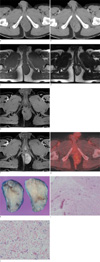Abstract
A variety of benign and malignant tumor can occur in the perianal space. Among them, cellular angiofibroma is a rare tumor that belongs to fibroblastic/myofibroblastic tumors of the WHO classification, sometimes called as "angiomyofibroblastoma-like tumor". Cellular angiofibroma can be found at various anatomic sites such as the vulva, perineum, genital tract, and inguinal regions with approximately equal gender ratio. This tumor is usually a well-circumscribed mass showing isosignal intensity to muscle on T1-weighted images. On T2-weighted images, cellular angiofibroma may show as a mass with inhomogeneous signal intensity depending on amount of composed spindle cell, collagenous stroma, myxoid matrix, and fat tissue; however it is characterized by low signal intensity due to fibrous tissues. This highly vascular mass shows strong enhancement on post contrast images. Recommended treatment is simple local excision and no recurrence or metastasis have been reported up to date.
Figures and Tables
 | Fig. 1A 43-year-old man with cellular angiofibroma. (a) Axial precontrast CT image shows an oval shaped mass in the left side perirectal space. (b) On axial postcontrast CT image, the mass shows heterogeneous enhancement. (c) Axial T1-weighted fast spin echo image shows iso-signal intense mass to the surrounding muscles. (d) On axial T2-weighted image, the mass shows internal heterogeneous signal intensity with hypointense peripheral rim. (e) Axial pre-contrast fat suppressed T1-weighted image shows iso-intense mass. (f) On post-contrast axial fat suppressed T1-weighted image, the mass shows well enhancement. (g) F-18 FDG PET-CT shows a mildly increased FDG uptake of the mass and no other abnormally increased FDG uptaken lesion to suggest lymph node involvement or distant metastasis (not shown). (h) On gross sections, the cut surface shows homogeneous partly lobulated grayish appearance with encapsulation. (i) Photomicrograph reveals a well defined mass with numerous thin-walled vascular channels (H & E, Magnification, ×40). (j) Photomicrograph reveals a proliferation of short spindle cells with numerous thin-walled vascular channels in the background of abundant collagenous stroma (H & E, Magnification, ×200). |
References
1. Iwasa Y, Fletcher CD. Cellular angiofibroma: clinicopathologic and immunohistochemical analysis of 51 cases. Am J Surg Pathol. 2004. 28:1426–1435.
2. Miyajima K, Hasegawa S, Oda Y, et al. Angiomyofibroblastomalike tumor (cellular angiofibroma) in the male inguinal region. Radiat Med. 2007. 25:173–177.
3. Koo PJ, Goykhman I, Lembert L, Nunes LW. MRI features of cellular angiomyofibroma with pathologic correlation. J Magn Reson Imaging. 2009. 29:1195–1198.
4. Fletcher CD, Tsang WY, Fisher C, Lee KC, Chan JK. Angiomyofibroblastoma of the vulva. A benign neoplasm distinct from aggressive angiomyxoma. Am J Surg Pathol. 1992. 16:373–382.
5. Nucci MR, Granter SR, Fletcher CD. Cellular angiofibroma: a benign neoplasm distinct from angiomyofibroblastoma and spindle cell lipoma. Am J Surg Pathol. 1997. 21:636–644.
6. Laskin WB, Fetsch JF, Mostofi FK. Angiomyofibroblastomalike tumor of the male genital tract: analysis of 11 cases with comparison to female angiomyofibroblastoma and spindle cell lipoma. Am J Surg Pathol. 1998. 22:6–16.
7. Samaratunga H, Fitzpatrick P. Cellular angiofibroma of the scrotum. Pathology. 2008. 40:330–333.
8. Sinha R, Verma R. Case 106: aggressive angiomyxoma. Radiology. 2007. 242:625–627.
9. Canales BK, Weiland D, Hoffman N, et al. Angiomyofibroblastoma-like tumors (cellular angiofibroma). Int J Urol. 2006. 13:177–179.




 PDF
PDF ePub
ePub Citation
Citation Print
Print


 XML Download
XML Download